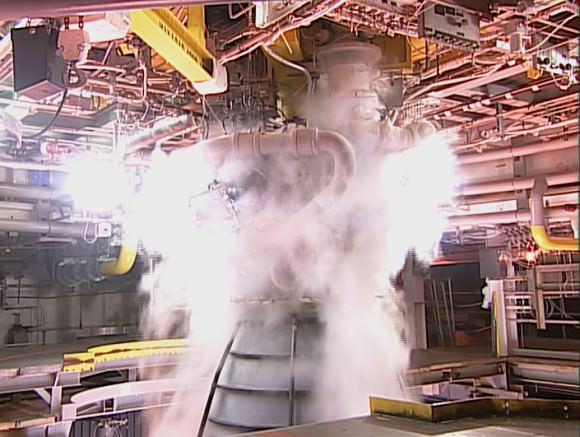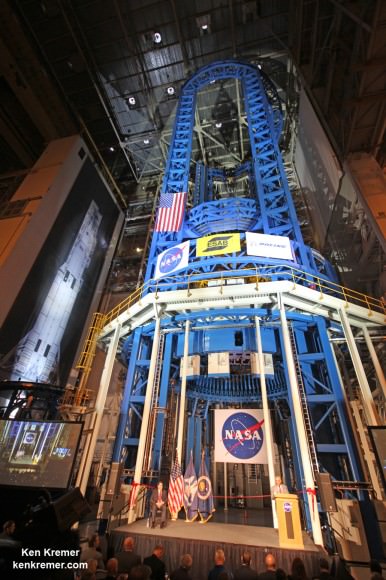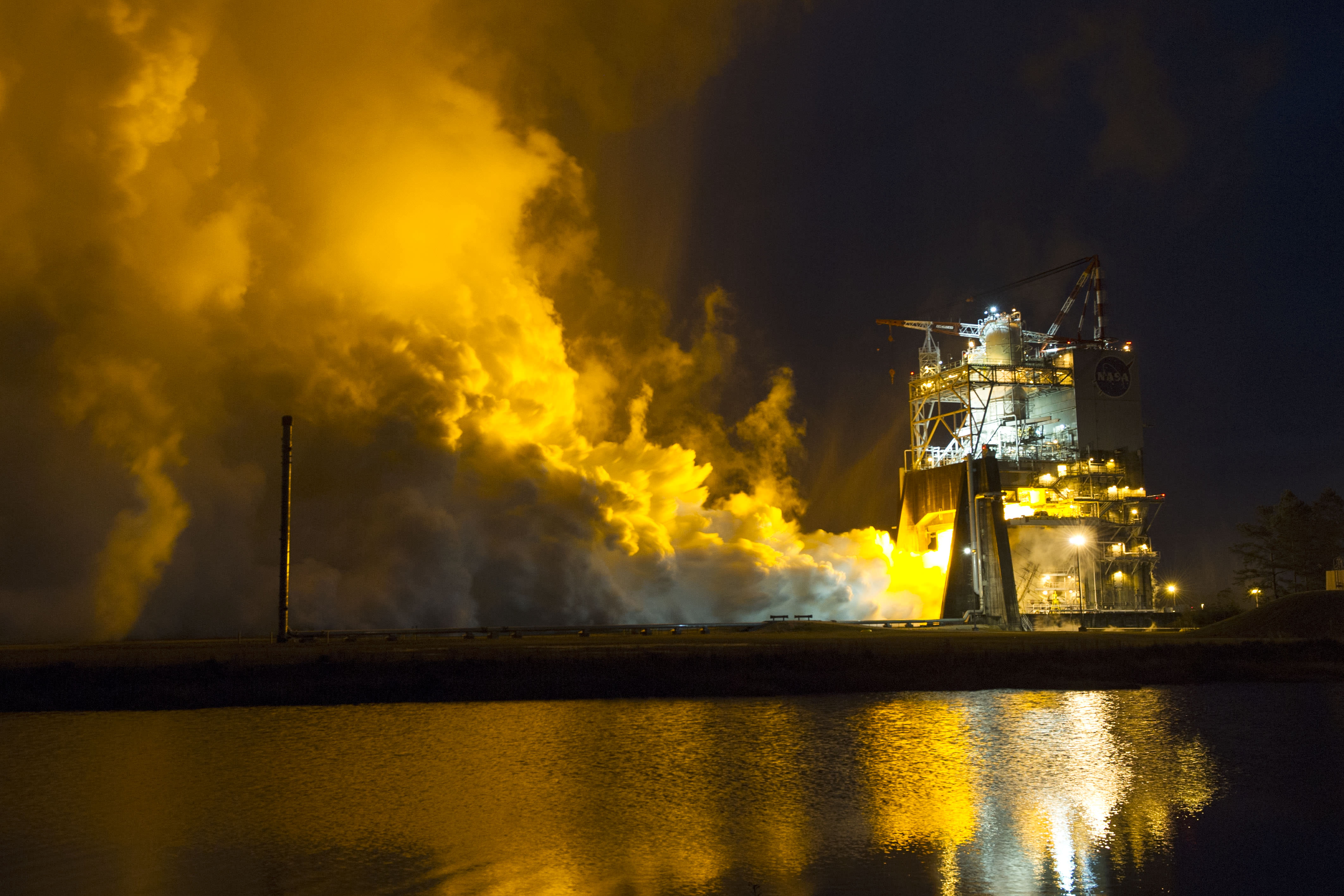NASA’s goal of sending astronauts to deep space took a major step forward when the first engine of the type destined to power the mighty Space Launch System (SLS) exploration rocket blazed to life during a successful test firing at the agency’s Stennis Space Center near Bay St. Louis, Mississippi.
The milestone hot fire test conducted on Jan. 9, involved igniting a shuttle-era RS-25 space shuttle main engine for 500 seconds on the A-1 test stand at Stennis.
A quartet of RS-25s, formerly used to power the space shuttle orbiters, will now power the core stage of the SLS which will be the most powerful rocket the world has ever seen.
“The RS-25 is the most efficient engine of its type in the world,” said Steve Wofford, manager of the SLS Liquid Engines Office at NASA’s Marshall Space Flight Center, in Huntsville, Alabama, where the SLS Program is managed. “It’s got a remarkable history of success and a great experience base that make it a great choice for NASA’s next era of exploration.”
The SLS is NASA’s mammoth heavy lift rocket now under development. It is intended to launch the Orion deep space crew capsule and propel astronauts aboard to destinations far beyond Earth and farther into space than ever before possible – beyond the Moon, to Asteroids and Mars.
The over eight minute RS-25 engine test firing provided NASA engineers with critical data on the engine controller unit, which is the “brain” of the engine providing communications between the engine and the vehice, and inlet pressure conditions.
“The controller also provides closed-loop management of the engine by regulating the thrust and fuel mixture ratio while monitoring the engine’s health and status. The new controller will use updated hardware and software configured to operate with the new SLS avionics architecture,” according to NASA.
This also marked the first test of a shuttle-era RS-25 since the conclusion of space shuttle main engine testing in 2009.
For the SLS, the RS-25 will be configured and operated differently from their use when attached as a trio to the base of the orbiters during NASA’s four decade long Space Shuttle era that ended with the STS-135 mission in July 2011.
“We’ve made modifications to the RS-25 to meet SLS specifications and will analyze and test a variety of conditions during the hot fire series,” said Wofford
“The engines for SLS will encounter colder liquid oxygen temperatures than shuttle; greater inlet pressure due to the taller core stage liquid oxygen tank and higher vehicle acceleration; and more nozzle heating due to the four-engine configuration and their position in-plane with the SLS booster exhaust nozzles.”
Watch this video of the RS-25 engine test:
Video Caption: The RS-25 engine that will drive NASA’s new rocket, the Space Launch System, to deep space blazed through its first successful test Jan. 9 at the agency’s Stennis Space Center near Bay St. Louis, Mississippi. Credit: NASA TV
The SLS core stage stores the cryogenic liquid hydrogen and liquid oxygen that fuel the RS-25 first stage engines.
“This first hot-fire test of the RS-25 engine represents a significant effort on behalf of Stennis Space Center’s A-1 test team,” said Ronald Rigney, RS-25 project manager at Stennis.
“Our technicians and engineers have been working diligently to design, modify and activate an extremely complex and capable facility in support of RS-25 engine testing.”
The Jan. 9 engine test was just the first of an extensive series planned. After an upgrade to the high pressure cooling system, an initial series of eight development tests will begin in April 2015 totaling 3,500 seconds of firing time.

The SLS core stage is being built at NASA’s Michoud Assembly Facility in New Orleans.
On Sept. 12, 2014, NASA Administrator Charles Bolden officially unveiled the world’s largest welder at Michoud, that will be used to construct the core stage, as I reported earlier during my on-site visit.
“This rocket is a game changer in terms of deep space exploration and will launch NASA astronauts to investigate asteroids and explore the surface of Mars while opening new possibilities for science missions, as well,” said NASA Administrator Charles Bolden during the ribbon-cutting ceremony at Michoud.
The core stage towers over 212 feet (64.6 meters) tall and sports a diameter of 27.6 feet (8.4 m).

The maiden test flight of the SLS is targeted for no later than November 2018 and will be configured in its initial 70-metric-ton (77-ton) version with a liftoff thrust of 8.4 million pounds. It will boost an unmanned Orion on an approximately three week long test flight beyond the Moon and back.
NASA plans to gradually upgrade the SLS to achieve an unprecedented lift capability of 130 metric tons (143 tons), enabling the more distant missions even farther into our solar system.
The first SLS test flight with the uncrewed Orion is called Exploration Mission-1 (EM-1) and will launch from Launch Complex 39-B at the Kennedy Space Center.
Orion’s inaugural mission dubbed Exploration Flight Test-1 (EFT) was successfully launched on a flawless flight on Dec. 5, 2014 atop a United Launch Alliance Delta IV Heavy rocket Space Launch Complex 37 (SLC-37) at Cape Canaveral Air Force Station in Florida.
Stay tuned here for Ken’s continuing Earth and Planetary science and human spaceflight news.

STS-135: Last launch using RS-25 engines that will now power NASA’s SLS deep space exploration rocket. NASA’s 135th and final shuttle mission takes flight on July 8, 2011 at 11:29 a.m. from the Kennedy Space Center in Florida bound for the ISS and the high frontier with Chris Ferguson as Space Shuttle Commander. Credit: Ken Kremer/kenkremer.com

